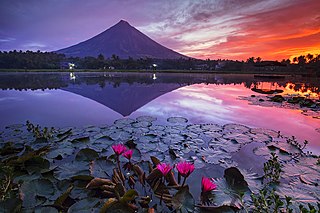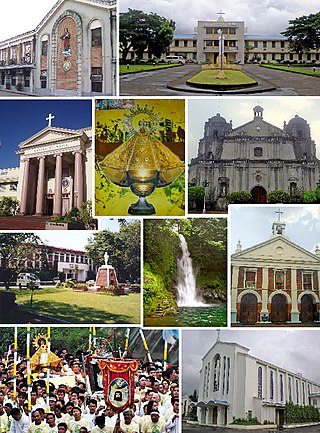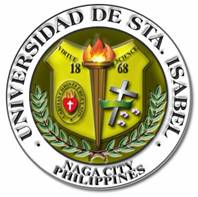
Albay, officially the Province of Albay, is a province in the Bicol Region of the Philippines, mostly on the southeastern part of the island of Luzon. Its capital is the city of Legazpi, the regional center of the whole Bicol Region, which is located in the southern foothill of Mayon Volcano.

Sorsogon, officially the Province of Sorsogon, is a province in the Philippines located in the Bicol Region. It is the southernmost province in Luzon and is subdivided into fourteen municipalities (towns) and one city. Its capital is Sorsogon City and borders the province of Albay to the north.

The Bicol Region, commonly shortened to Bicol and designated as Region V, is an administrative region of the Philippines. Also referred to as Bicolandia, it comprises six provinces, four on the Bicol Peninsula : Albay, Camarines Norte, Camarines Sur, and Sorsogon, and two off the shore: Catanduanes and Masbate.

Camarines Sur, officially the Province of Camarines Sur, is a province in the Philippines located in the Bicol Region on Luzon. Its capital is Pili and the province borders Camarines Norte and Quezon to the northwest, and Albay to the south. To the east lies the island province of Catanduanes across the Maqueda Channel.

Camarines Norte, officially the Province of Camarines Norte, is a province in the Philippines located in the Bicol Region in Luzon. Its capital is Daet. The province borders Quezon to the west, Camarines Sur to the south, and the Philippine Sea to the north. It has historically been a Bikol-speaking region. However, there has been a language shift in recent years to Tagalog, which is more commonly used nowadays.

Polangui, officially the Municipality of Polangui, is a 1st class municipality in the province of Albay, Philippines. According to the 2020 census, it has a population of 89,176 people.

Naga, officially the City of Naga, Spanish: Ciudad de Nueva Cáceres, or the Pilgrim City of Naga, is a 1st class independent component city in the Bicol Region of the Philippines. According to the 2020 census, it has a population of 209,170 people.

The Bicolano people are the fourth-largest Filipino ethnolinguistic group. Their native region is commonly referred to as Bicolandia, which comprises the entirety of the Bicol Peninsula and neighboring minor islands, all in the southeast portion of Luzon. Males from the region are often referred to as Bicolano, while Bicolana may be used to refer to females.

The Universidad de Sta. Isabel, also simply referred to as USI or Sta. Isabel, is a private Catholic university run by the Sisters of Charity of Saint Vincent De Paul in Naga, Camarines Sur, Philippines. It was founded by the Rt Rev. Francisco Gainza, O.P., Bishop of Caceres, in 1868 as the first normal school for women in the Philippines and Southeast Asia, named in honor of the university's patron, St. Isabel, Queen of Hungary.

The Thirteen Martyrs of Cavite were Filipino patriots in Cavite, Philippines who were executed by musketry on September 12, 1896, for cooperating with the Katipunan during the Philippine Revolution against Spain. The de facto capital city of Trece Martires in Cavite is named after them.
Capital punishment in the Philippines specifically, the death penalty, as a form of state-sponsored repression, was introduced and widely practiced by the Spanish government in the Philippines. A substantial number of Filipino national martyrs like Mariano Gómez, José Burgos, and Jacinto Zamora, Thirteen Martyrs of Cavite, Thirteen Martyrs of Bagumbayan, Fifteen Martyrs of Bicol, Nineteen Martyrs of Aklan and Jose Rizal were executed by the Spanish government.

Central Bikol, commonly called Bikol Naga or simply as Bikol, is an Austronesian language spoken by the Bicolanos, primarily in the Bicol Region of southern Luzon, Philippines. It is spoken in the northern and western part of Camarines Sur, second congressional district of Camarines Norte, eastern part of Albay, northeastern part of Sorsogon, San Pascual town in Masbate, and southwestern part of Catanduanes. Central Bikol speakers can be found in all provinces of Bicol and it is a majority language in Camarines Sur. The standard sprachraum form is based on the Canaman dialect.

Tomás Arejola y Padilla was a Filipino lawyer, legislator, diplomat, political writer and a propagandist during the Spanish colonial period. A mason and a liberal, he openly campaigned for political reforms in the Philippines. But this was to pass and the Americans took over. During the Commonwealth period, Arejola joined the Nacionalista Party becoming its first vice-president and twice in the elections of 1907 and 1911 was elected the Representative of Ambos Camarines.
This is a list of notable events that happened in the Philippines in the year 1897.
1896 in the Philippines details events of note that happened in the Philippines in the year 1896.

The Fifteen Martyrs of Bicol were Filipino patriots in Bicol, Philippines who were executed by firing squad on January 4, 1897, for cooperating with the Katipunan during the Philippine Revolution against Spain.

The Thirteen Martyrs of Bagumbayan were Filipino patriots in the Philippines who were executed by musketry on January 11, 1897, for cooperating with the Katipunan during the Philippine Revolution against Spain.

The Bikol languages or Bicolano languages are a group of Central Philippine languages spoken mostly in the Bicol Peninsula in the southeastern part of Luzon, the neighboring island-province of Catanduanes, and the island of Burias in Masbate.
This is the timeline of the Philippine Revolution—the uprising that gave birth to Asia's first republic. The roots of the revolution trace back to the Cavite mutiny and subsequent execution of Gomburza in 1872, and ended with the declaration of independence from Spain in 1898.
















